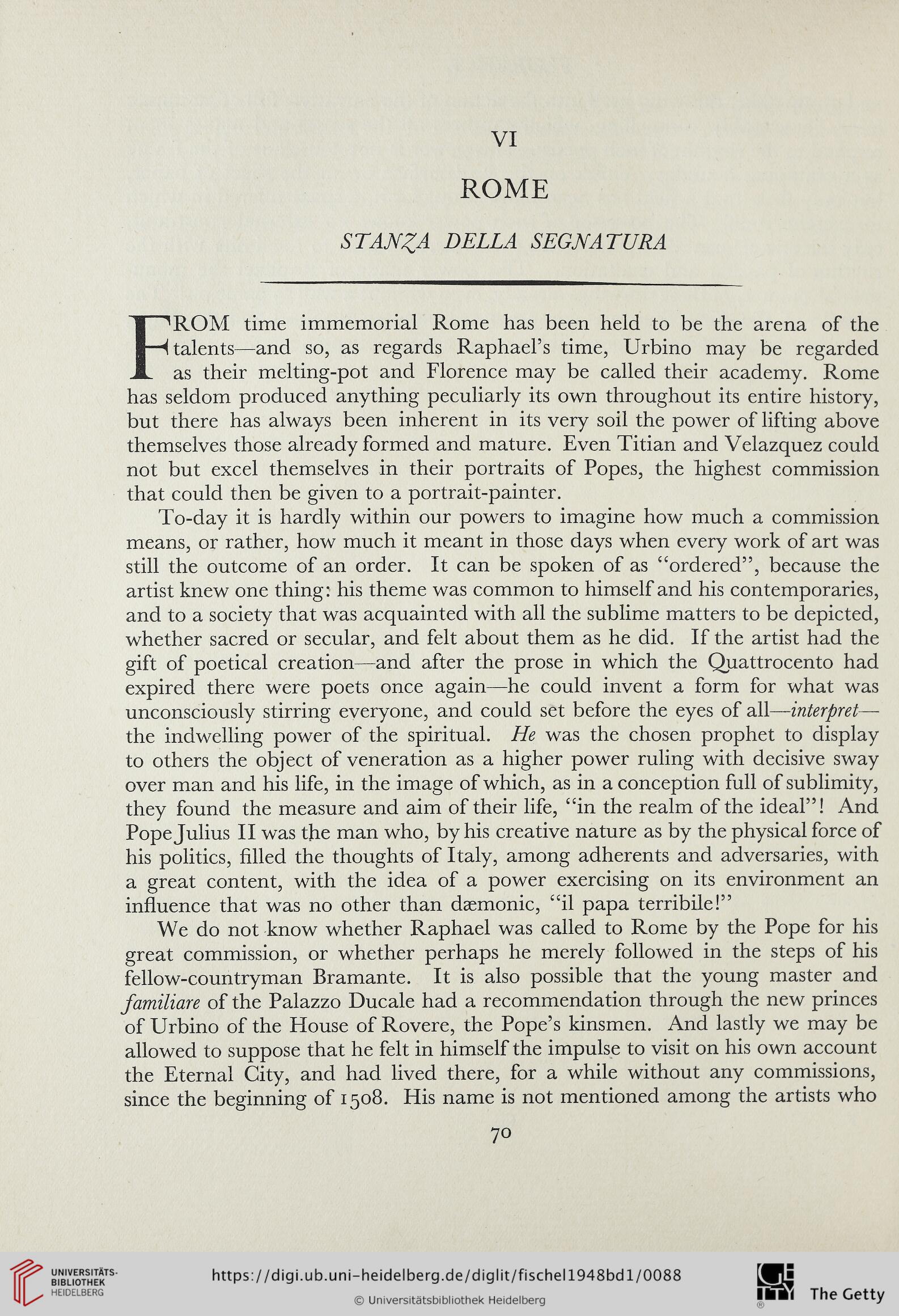VI
ROME
STANZA della segnatura
FROM time immemorial Rome has been held to be the arena of the
talents—and so, as regards Raphael’s time, Urbino may be regarded
as their melting-pot and Florence may be called their academy. Rome
has seldom produced anything peculiarly its own throughout its entire history,
but there has always been inherent in its very soil the power of lifting above
themselves those already formed and mature. Even Titian and Velazquez could
not but excel themselves in their portraits of Popes, the highest commission
that could then be given to a portrait-painter.
To-day it is hardly within our powers to imagine how much a commission
means, or rather, how much it meant in those days when every work of art was
still the outcome of an order. It can be spoken of as “ordered”, because the
artist knew one thing: his theme was common to himself and his contemporaries,
and to a society that was acquainted with all the sublime matters to be depicted,
whether sacred or secular, and felt about them as he did. If the artist had the
gift of poetical creation—and after the prose in which the Quattrocento had
expired there were poets once again—he could invent a form for what was
unconsciously stirring everyone, and could set before the eyes of all—interpret—
the indwelling power of the spiritual. He was the chosen prophet to display
to others the object of veneration as a higher power ruling with decisive sway
over man and his life, in the image of which, as in a conception full of sublimity,
they found the measure and aim of their life, “in the realm of the ideal”! And
Pope Julius II was the man who, by his creative nature as by the physical force of
his politics, filled the thoughts of Italy, among adherents and adversaries, with
a great content, with the idea of a power exercising on its environment an
influence that was no other than daemonic, “il papa terribile!”
We do not know whether Raphael was called to Rome by the Pope for his
great commission, or whether perhaps he merely followed in the steps of his
fellow-countryman Bramante. It is also possible that the young master and
familiare of the Palazzo Ducale had a recommendation through the new princes
of Urbino of the House of Rovere, the Pope’s kinsmen. And lastly we may be
allowed to suppose that he felt in himself the impulse to visit on his own account
the Eternal City, and had lived there, for a while without any commissions,
since the beginning of 1508. His name is not mentioned among the artists who
70
ROME
STANZA della segnatura
FROM time immemorial Rome has been held to be the arena of the
talents—and so, as regards Raphael’s time, Urbino may be regarded
as their melting-pot and Florence may be called their academy. Rome
has seldom produced anything peculiarly its own throughout its entire history,
but there has always been inherent in its very soil the power of lifting above
themselves those already formed and mature. Even Titian and Velazquez could
not but excel themselves in their portraits of Popes, the highest commission
that could then be given to a portrait-painter.
To-day it is hardly within our powers to imagine how much a commission
means, or rather, how much it meant in those days when every work of art was
still the outcome of an order. It can be spoken of as “ordered”, because the
artist knew one thing: his theme was common to himself and his contemporaries,
and to a society that was acquainted with all the sublime matters to be depicted,
whether sacred or secular, and felt about them as he did. If the artist had the
gift of poetical creation—and after the prose in which the Quattrocento had
expired there were poets once again—he could invent a form for what was
unconsciously stirring everyone, and could set before the eyes of all—interpret—
the indwelling power of the spiritual. He was the chosen prophet to display
to others the object of veneration as a higher power ruling with decisive sway
over man and his life, in the image of which, as in a conception full of sublimity,
they found the measure and aim of their life, “in the realm of the ideal”! And
Pope Julius II was the man who, by his creative nature as by the physical force of
his politics, filled the thoughts of Italy, among adherents and adversaries, with
a great content, with the idea of a power exercising on its environment an
influence that was no other than daemonic, “il papa terribile!”
We do not know whether Raphael was called to Rome by the Pope for his
great commission, or whether perhaps he merely followed in the steps of his
fellow-countryman Bramante. It is also possible that the young master and
familiare of the Palazzo Ducale had a recommendation through the new princes
of Urbino of the House of Rovere, the Pope’s kinsmen. And lastly we may be
allowed to suppose that he felt in himself the impulse to visit on his own account
the Eternal City, and had lived there, for a while without any commissions,
since the beginning of 1508. His name is not mentioned among the artists who
70




